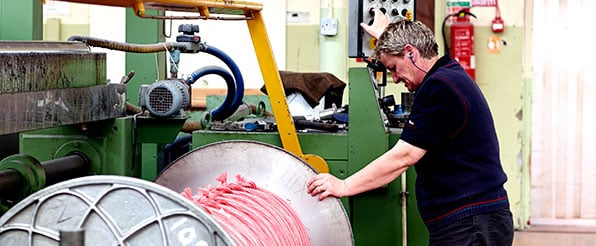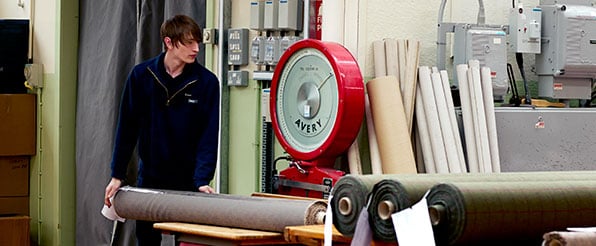Even when our looms are working at full speed, people have a vital supervisory role to play. Keen eyes preside over all stages of the weaving process to ensure that each fabric produced by Robert Noble is of the same consistently high quality.
WARPING
The yarn spun in these ways is stored in a yarnstore. Having organised the different yarns so as to be readily accessible when required, the yarnstore foreman sends out the material for warp preparations and other preparatory weaving processes.
Warping involves running onto a large reel or warp mill lengths of yarn that are the full length of each thread in the piece of cloth to be woven.
When warping is complete, all the threads that are to be woven into the cloth are arranged in their full length according to the pattern and are then correctly spaced. From the large reel or warp mill, the completed warp is run onto a small diameter roller or beam that can be mounted in a loom. In preparation for this, the ends of each of the warp threads are drawn through the mails carried by healds, which are transferred to a loom along with the warp. The ends of the threads are also sleyed through the wires of a reed. The wires of the reed are precisely spaced, giving the threads the exact setting required for the weaving of the cloth.
WEAVING
A woven fabric is made from two series of yarns. These are the warp, described above, and the weft or filling. The weft is passed between the warp threads that are lifted and lowered separately by the loom according to the desired pattern.
The beam around which the warp has been wound, accompanied by the healds and reed through which the warp threads have been drawn, is then mounted in a loom. The healds are attached to the different lifting jacks and the reed firmly fixed in position. The leading ends of the warp threads are then tied to an apron that is drawn slowly forward as weaving takes place.
The loom also selects the weft yarns according to the colours required and boasts a number of other mechanical features designed to assist production, including mechanisms to stop the loom should a thread break or a weft pick fail.
It is the work of a tuner – a specialist engineer with a craftsperson’s understanding of cloth weaving – to maintain the efficiency of the loom. The weaver operates the loom, skilfully observing the process at all times to make sure that no faults go unnoticed.
MENDING
The web of cloth removed from the loom is raw and thready in appearance, dull in colour, open in texture and rough to the handle. It is passed to the finishing departments to be given the appropriate finish required. In all cases, the cloth is first closely inspected for faults and blemishes, with a note made of any special finishing processes needed.
Any yarns missing for short distances – because of a breakage not immediately detected at the weaving stage, for example – are darned in to the exact interlacing that the missing length would have had. Wrong interlacing’s sometimes appear and these too can be corrected by darners. Darners are specially skilled in weave interlacing’s and the term ‘invisible mending’ often applied to their work because of their skill in darning the selfsame yarns in the exact interlacings.
The occasional knots that occur in yarns are carefully handled so as to avoid appearing in the yarns as either thickened spots or gaps. As well as knots, the builers examine cloth for of any thickened lengths of yarn, slack lengths or similar.
FINISHING
From the darning department, cloth is passed to the millhouse, where it is invariably washed or scoured and often fulled or milled as well. Cloth scouring – piece scouring as it is usually called – is done in a machine consisting mainly of a couple of large, smooth rollers above a deep trough in which the scouring liquor is held. The exact type of liquor required depends upon the type of spinning oil used, but in any case it is usual to remove the bulk of the oil in a first graith and give the cloth a final wash in clean water. The cloth immediately loses its thready appearance, colours come up bright and clear, the texture closes up considerably and the handle becomes soft and kindly.
If greater density of texture is wanted, the cloth is then fulled – either in fulling stocks or in a milling machine. With suitable wools, appropriately spun yarns and the correct weave interlacing’s, great density of texture is possible.
Millhouse operations result in a certain amount of shrinkage, which has been allowed for, and in the subsequent drying process care is taken to arrange the tentering machine to deliver cloth of the appropriate dimensions. Making provision for reconditioning after drying is essential, either by steaming or using one or other of the moisture conditioning machines. In every case, time must be allowed for the wool to absorb its natural level of moisture. Otherwise the piece of cloth will fail to respond properly to subsequent processing and its handle will be adversely affected.
CROPPING
In the process of cutting or cropping, the cloth is run through a machine with rotating spiral blades operating against a fixed blade in the same manner as a lawn mower. The irregular mane of surface fibres is cut to a uniform level, whether in a high cut – providing a soft, mossy, handle – or a smart close cut, which displays the colour and weave pattern clearly.
A cloth pressing process is often used for the finest apparel cloths. Here, the cloth is folded layer by layer with smooth cardboard squares and placed in a hydraulic press. By applying a small amount of heat, a suitably conditioned cloth acquires lustre and body greater than that attained during the blowing process. The process requires good judgment of the amount of conditioning, healing and pressure required to produce the best results.
DISPATCHING
The finished piece of cloth is given a final close inspection, then measured, weighed and folded onto boards or rolled onto full-width tubes, in accordance with the customer’s requirements, before being passed to the warehouse. In the warehouse, the cloth is linked to the order for which it was made and warehouse staff follow the despatch instructions specified by the customer – for example, the type of packaging and method of shipment required and the customer’s preferred shipping firm. Once despatched, the order – complete with the final cloth measurement and weight, plus the weight and measurement of the bale or roll – is passed to the invoicing section to process the relevant paperwork for the customer.







